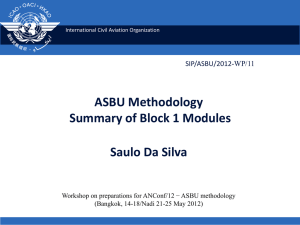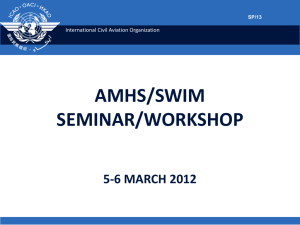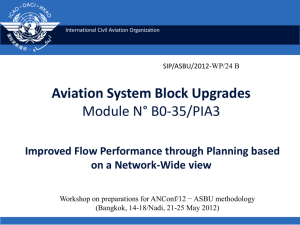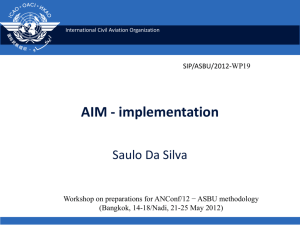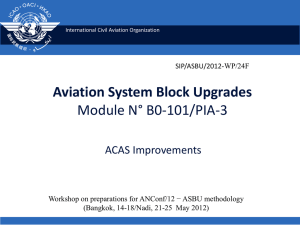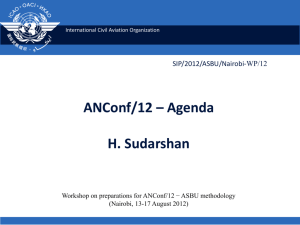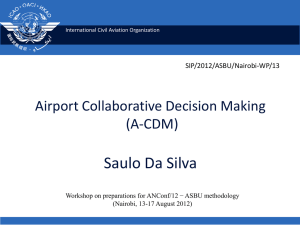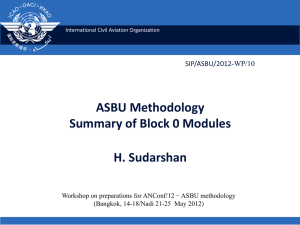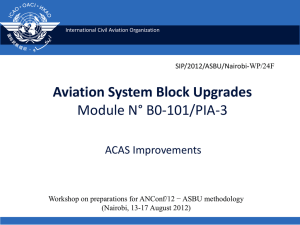Economic issues - Formulation of Business cases
advertisement
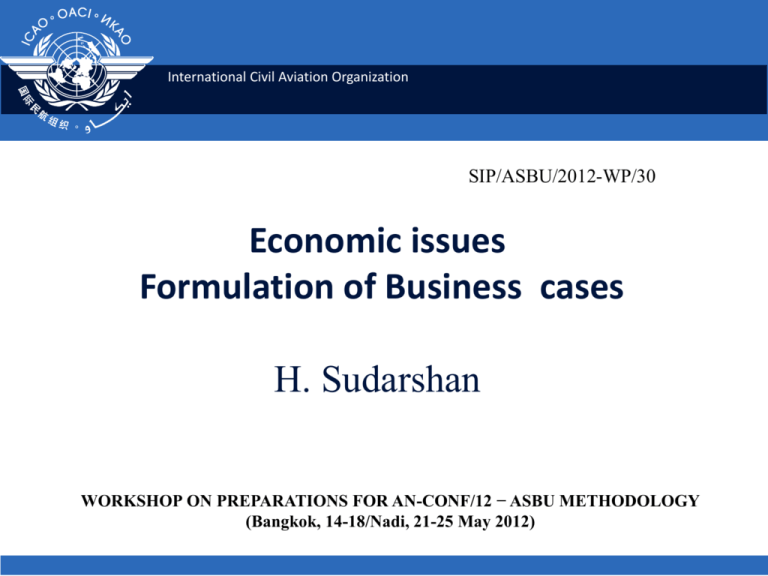
International Civil Aviation Organization SIP/ASBU/2012-WP/30 Economic issues Formulation of Business cases H. Sudarshan WORKSHOP ON PREPARATIONS FOR AN-CONF/12 − ASBU METHODOLOGY (Bangkok, 14-18/Nadi, 21-25 May 2012) Outline • Economic aspects of Global ATM System – Costs – Benefits – Cost/benefit studies – Business Case – Funding – Cost recovery • Organizational format 2 ICAO SIP 2012 - ASBU workshops Economic and organizational aspects related to Global ATM Operational concept • States should strive for the efficient and cost-effective implementation of the global ATM operational concept, using the GANP as the implementation planning document, through international cooperation and collaboration within the ATM community; and • States should consider facilitating implementation of the global ATM operational concept by adopting, where appropriate, a regional approach in order to enhance transparency, efficiency, fairness, comparability and predictability of the costs of air transport infrastructure 3 ICAO SIP 2012 - ASBU workshops System elements Air Navigation infrastructure to Support ATM Operational Concept – – – – – 4 ATM CNS AIM AGA MET ICAO SIP 2012 - ASBU workshops Allocation of costs ... Cost/ Benefit Item CAA Aircraft Operators Total Costs of Air Navigation System elements Capital costs and Recurring costs Ground X X Aircraft Training X X Purchases from intermediate service providers TOTAL X X C1 C2 C 5 Allocation of Costs • Resolution A32-19 provides guidelines. • Cost allocation issues – multi-modal services – allocation options • Categories Aeronautical and non-aeronautical Airport and en-route operations Commercial and non-commercial users 6 ICAO SIP 2012 - ASBU workshops Capital investment Who is responsible? • States • Service providers • Airspace users 7 ICAO SIP 2012 - ASBU workshops Again, how much? Depends on the implementation options! ICAO SIP 2012 - ASBU workshops 8 X N — collision risk F — fuel conservation E — material expenditure T — time Gain E1 (future system) X X N F X Loss X E0 (traditional system) X X T0 T1 General trend in the variation of the main factors of the ATM system 9 ICAO SIP 2012 - ASBU workshops T Benefits Airlines benefits State benefits Route optimization (time, fuel) Optimum altitudes Dynamic aircraft route planning More alternate airports Reduced contingency fuel Possible reduced crewing Increased aircraft utilization Greater payload capability Greater revenue generation Improved level of service Consolidation of facilities Reduced maintenance costs Avoided capital costs Airport benefits Increased airports capacity Improved airside management Decrease in diversions in instrument meteorological conditions Enhanced revenues Happy passenger 10 ICAO SIP 2012 - ASBU workshops Allocation of benefits Cost/Benefit Item CAA Aircraft Operators Passengers Totals Benefits of Air Navigation Systems elements Avoided equipment costs (Present technology) Ground Aircraft Efficiency improvements Passenger time savings TOTAL 11 X — X — X X — — — — — X B1 B2 B3 ICAO SIP 2012 - ASBU workshops B Benefit shares CAA/Airports Present technology Equipment (avoided cost) Airlines Operating Efficiencies 25% 61% 14% Airlines Present technology Avionics (avoided cost) 12 Cost/Benefit studies • The cost/benefit study to address the financial viability and implementation options • Measure of economic viability Net present value (preferred method: Benefit-Costs>0) Cost-effective Least cost Snapshot Utility value Pay-off period Sensitivity analysis Analysis to ensure wide fluctuations in changing data conditions are taken into account Validate the model using the best judgment 13 ICAO SIP 2012 - ASBU workshops What is Business case ? A tool supporting planning and decision-making that can be used by public as well as private entities Cost/ Benefit Analysis Financial Analysis Risk Analysis Business case ICAO SIP 2012 - ASBU workshops 14 Business Case and Business Plan • A business case: –is specific to a project, a policy or a program proposal, and –covers the lifecycle of the proposal; • A business plan –normally covers an entire organization or enterprise, and –is limited in time (typically 3 to 5 years) ICAO SIP 2012 - ASBU workshops 15 Why do we need a Business case? • To convince the target audience: – of the need for the proposal – of the feasibility of the proposal – that the proposal is cost effective and beneficial – that the proposal is financially viable – that the risks involved are manageable • To be able to prioritize proposals ICAO SIP 2012 - ASBU workshops 16 Content of a Business Case • The main sections of a business case are: – Description of the proposal – Identification of the stakeholders / partners – Cost-benefit analysis – Financial analysis – Risk analysis and management ICAO SIP 2012 - ASBU workshops 17 Funding Sources of financing include: Contribution from governments (national or foreign) Commercial sources (debt financing) Accumulated excess of revenues over costs (profits) Bonds Equity financing (share capital) Leasing ICAO SIP 2012 - ASBU workshops 18 Cost recovery Cost allocation and cost recovery principles are set forth in ICAO Document 9082 Methods of cost recovery Direct collection from users Joint charges collection agency Delegation to external agency ICAO SIP 2012 - ASBU workshops 19 Organizational format for ANSPs Level Type of Organization National Government department Autonomous public sector undertaking Private organization Multinational/ Subregional/ Regional Global Service provided by one government Service provided by group government Organization with own legal responsibility Service provided by one government Service provided by group government Organization with own legal responsibility 20 ICAO SIP 2012 - ASBU workshops 21
